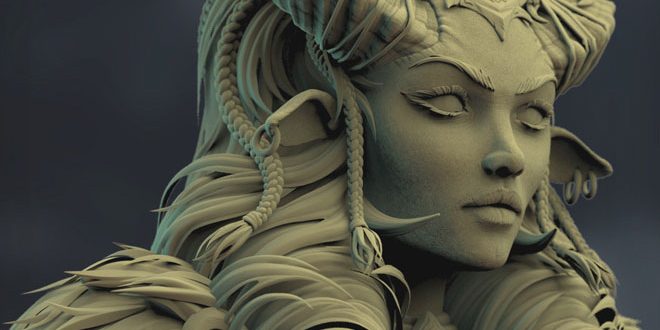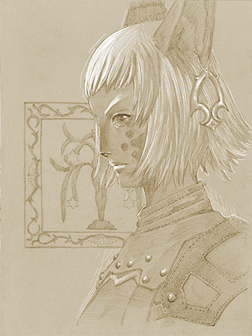General Species Information
Upon a proud world
Under a shimmering sky
There lived a pure, hardened people
The azu, alternatively known as Anukuians, are the multi-ethnic race of cat-like humanoids that wield dominion over Anuku, a verdant and opulent world that is, in many ways, homologous to Earth. Comparative in size to a large human specimen, azu are sharp of mind and lithe of frame, and can negotiate terrain with lightning tempo and supple grace when on the prowl. Other than being benefited with an excellent sense of vision, smell, and hearing, azu can discern the dynamic position of an object in motion by detecting latent changes in surrounding air pressure, feel faint vibrations through the soft pads of their hind paws, identify oscillating electromagnetic waves emanated by the heart of another living organism, and pick up subtle alterations in the pheromone secretion patterns of living creatures.
The azu species lacks the faculty to produce psionic users, but the mind of every one of them naturally discharges a nullifying field of "negative energies" that severely inhibits the effectiveness of nearby otherworldly powers, with this field rapidly growing in geometric strength when swelling groups of azu congregate in one locality. Anuku is home to billions of azu, thereby causing this field to span throughout Anuku's parent system.
As a result of an uncorrectable anomalous fault in their genome, the azu sex ratio is heavily skewed in favor of the azu female, with the current population of azu (stated to be circa 3.25 billion) being 90/10 (female/male) in numerical composition.
Government
Complex Paramount Chiefdom
Foreign Policy and Public Opinions of Aliens
Anuku, while culturally diverse, is figuratively (and in some circles, literally) described as a “one-race world” by azu social scientists and political leaders, with this bold, racially-charged declaration stemming from the racial homogeneity that propagates through the cultural pillars of the Lone World's multitude of tribal societies. Many of Anuku's ethnocentric inhabitants are quite condemnatory in their prejudice judgments of the greater galactic community, and cite Anuku's past confrontations with imperialistic alien invaders and disagreeable migrants as irrefutable verification that the
obri (or the "Other") are instinctively incompatible with azu culture and will, inevitably, pose a significant threat to all life on the Lone World if allowed to corrupt her surface with their foul touch. Unsurprisingly, Anuku's seven paramount chiefdoms have jointly implemented a sequence of isolationist decrees that forbid Anuku's star lords from fraternizing with aliens and alien civilizations in any shape or form, though these laws have been wavered, in the past, to facilitate brief instances of trade between the azu and "tolerable" xeno races.
Military
Azu militia forces are exacted from local tribal communities and their encompassing septs during times of war. Owing to their idiosyncratic physiological and psychological characteristics, azu land army battle doctrine hinges strongly on mobility, flexibility, and longevity to sustain an effective guerrilla campaign against invading forces. Azu abhor lengthy and grueling battles of attrition, favoring instead to execute covert raids on an opponent's supply lines and any lightly-defended positions using a combination of self-propelled guns (including tank destroyers and duel-purpose assault guns), powered crash-kill tiger and air scourge cavalry, and light infantry.
Anuku's seven battle spheres are enormous monitor spacecraft that linger several million kilometers away from her. A battle sphere is an assault fleet in all but title, its rounded bulk protected by meters of electro-reactive hydro-armor, a siege-grade PDF, and a strengthened superstructure wrought from hyper-dense composite materials forged in specialized zero-G factories. Battle spheres are divided into 30 fully-autonomous fighting compartments, each one bestowed with its own network of submersible phased graser and particle accelerator arrays, nuclear reactor, active cooling systems, crew quarters, and capacitor banks, and can dispatch disposable "combat mirrors" that--if positioned correctly--can offer the entire sphere the opportunity to effectively direct their beams around planets.

Anuku does not control a formal space force, but she is chaperoned by a vast number of phased graser array installations and particle accelerator gun emplacements that trickle the Lone World's surface. Most are stationary, but their married firepower is herculean; entire enemy assault fleets, anti-planetary missiles, and RKVs can be handily obliterated from frighteningly long distances within a infinitesimal length of time. Their employment of azu capital-grade PDF modules coupled with their cataclysmic power necessitates the need for ground-based infantry operations if a successful invasion is to be carried out by belligerent forces.
Technological Overview
Outwardly, the azu appear to be a pre-industrial civilization, but this observational conclusion is misleading. On the contrary, the azu deliberately strangle and shroud their factual technical prowess in a proactive attempt to stay the cultural stagnation and genetic degradation that customarily befalls an intellectually-gifted species that overindulges in the prolific “benefits” that sophisticated scientific advancements often promises. In a way, this global philosophical perspective can easily be compared to modern Neo-Luddism, though azu communities specifically avoid technologies that encourage excessive slothfulness, restrictive antisocial behavior, and weakness (either in a physical or mental context) rather than holding the unrealistic conviction that most technology is harmful to the Lone World or her azu masters.
To the rest of the galaxy, azu household technical applications appear horrendously outdated, amateurish, and inefficient. Food preservation, for example, has never edged beyond drying, smoking, jugging, salting, pickling, or canning, with azu fare never actually being produced in a food processing plant of any sort. Azu foodstuffs spoil faster than other noshes preserved using more modern modus operandi, but they are conversely free of injurious chemicals and excess quantities of sodium and sugar. Clothes are made by hand, while firearms are crafted using reinforced hand tools, archaic manually-operated machinery, and decades of gunsmithing experience. Very few azu homes have electricity for interior lighting or recreational needs, instead investing in a scant bundle of candles for a minuscule amount of illumination and a small solar panel and battery bank combination to sustain a highhouse's powered appliances. Power generation for larger azu settlements and the vast network of underground manufactorums is provided by thorium fission reactors, geothermal generators, or hydroelectric dams.
Azu military technology (with special mention going to azu-made weapons in particular) is moderately sophisticated, and is renowned for its utilitarian qualities, innate hardiness, and relative affordability. Many azu hand-held weapons have always been chiefly engineered to bring down Anuku's heavily-armored ultrafauna, resulting in later incarnations of chemical-based ballistic weaponry being specialized for maximum stopping power, accuracy, range, and penetration at the cost of cyclic rate. Most azu firearms are select-fire battle rifles, semi-automatic bolt-action rifles, revolvers, and 2 (or 4) bore paradox guns that are chambered for rocket-boosted hypervelocity cartridges.
Azu power deflection field technology is dissimilar to the galactic standard in that individual shield modules do not lose "energetic integrity" when successful attacks have been negated, but rather are "rated" according to how much energy the field can reliably contend with. This makes users of PDFs effectively immune to weapons systems or attacks that are below their shield's threshold, but vulnerable to weapons that can exceed it. Azu never conceived powered hardsuits, but instead ushered in shadow veil armor, a hooded "stealth robe" made from nano-engineered meta-materials, dense ballistic fiber bundles, linked armor discs, and layers of dilatant smart fluid that masks the wearer's electromagnetic signature, optical profile, and provides superb protection from energy-based weaponry, projectile-based weaponry, heat, and blast over-pressure. Low-cost powered exoskeletons can be worn underneath shadow veil armor.
Description of Society and Culture
You don't hunt alone. Never hunt alone. You hunt as one.
Azu culture values self-determinism, minimalism, collectivism, and loyalty. Azu adolescents-- colloquially refereed to as “kits” by the Lone World's encompassing azu population—are educated in the fundamental artistry of the august survivalist by elder members of the tribe. A distinct (but ultimately secondary) emphasis is placed on adequately honing their apprehension of the clan's spiritual and cultural mores, teaching the importance of family, and promoting a minimalistic lifestyle. By the time that they are of breeding age, most juvenile azu females and males have a predisposition for exhibiting stalwart behavior and operating in a persistent mode of semi-autonomy. "Gifted" azu are convinced to pursue rigorous instruction in one of the more prestigious institutional sectors of academia that reside within the
Peaks of Hia-Hia, an unforgiving geographical locale of historical importance where a prodigious amount of the azu's technological innovations primarily originate from.
Azu homesteads, called highhouses, are a queer mixture of an archetypal longhouse and a standard low-capacity semi-subterranean dwelling (such as an earth berm), and are fabricated from readily-available materials (in example: stone, timber, or bone) using un-powered utensils and powerful beasts of burden. Highhouses are comparatively voluminous, playing host to a number of necessary domestic facilities (such as larders, armories, storage enclosures, libraries, or washrooms) and over one-hundred families that are situated along a series of quasi-segregated living floors. Being in such close proximity with one another usually leads to family groups being acquainted on an intimate level; from these tight-knit relationships, inter-familial gatherings--like ceremonial dances or recreational group hunting sessions--are organized and initiated, in turn strengthening the clan's bond and encouraging goodwill and harmony throughout the masses. Aside from personal effects, clan members openly share most things, and--unlike many other species--observe a weedy quota of personal space, instead preferring to brush up against and caress other clan members if at all able. Stroking the ears, the underside of the tail, and the lower back are all considered profound signs of affection and trust.
Regardless of their internal layout and external attributes, azu highhouses are matriarchal in their fashion of administration, matrifocal in their familial structure, and matrilateral in their inheritance lines, with a wise woman and her selected “elder council” of middle-aged azu women wielding uncontested authoritative influence over the clan's members. As azu males are numerically scarce across Anuku, they are universally perceived and handled as treasured commodities that have tremendous barter value, and are subsequently forced into arranged polygamous “mating sessions” with outside harems of suitable azu women for the clan's own monetary gain, its political elevation, or its social evolution.
Azu mating paradigms center around a single eugenics-like "code of conduct", called
ormku, which preaches that only the "fit" are "fit" for reproduction. Azu tribal society does not suffer the frail and flawed to persist in life; the physically, intellectually, and emotionally disabled are subjected to forced sterilization when detected, and may experience harsh instances of rejection, overt communal ostracization, being abandoned at birth, and even being outright executed if their afflictions are particularly disparaging.
On average, azu males sire over 1,000 fit children throughout their lifetime.
Ever since its initial conception, the firearm has operated as a critical and intricate facet of azu warrior-hunter philosophy. Primordial dogma espouses that the gun is a sanctified and arcane artifact of moving power and importance, ergo being deserving of nothing less than unadulterated homage and unmitigated reverence. Azu battle rifles, handguns, fowling pieces, and other small arms are passed down from generation to generation and, in respect to the weapon's previous band of carriers, are customarily personalized with a conservative integer of aesthetic augmentations. In spite of widespread firearm proliferation, the azu's apathetic take on open carry policies has not culminated in a turbulent amount of gun-related crime, with the Lone World boasting an extraordinarily low murder rate overall.
Though their fur-covered forms only require clothing in diminutive quantities, a fractional grade of modesty is nonetheless encouraged when out in public, with azu attire being fundamentally tailored to softly accommodate the body, not to smother or dominate it. More often than not, azu tribal apparel tends to be passably revealing, only affording sufficient coverage for the wearer's nether regions and breasts. Vests, wrist wraps, skirts, chest bands, thongs, cloth vambraces, and loincloths, woven from fine silk-like fabrics or treated animal hides, are the standard. Many azu men and women decorate their person with a fulsome (but elegant) composite display of jewelery, fur dyes, and body piercings for a spot of comforting individualism.
********








